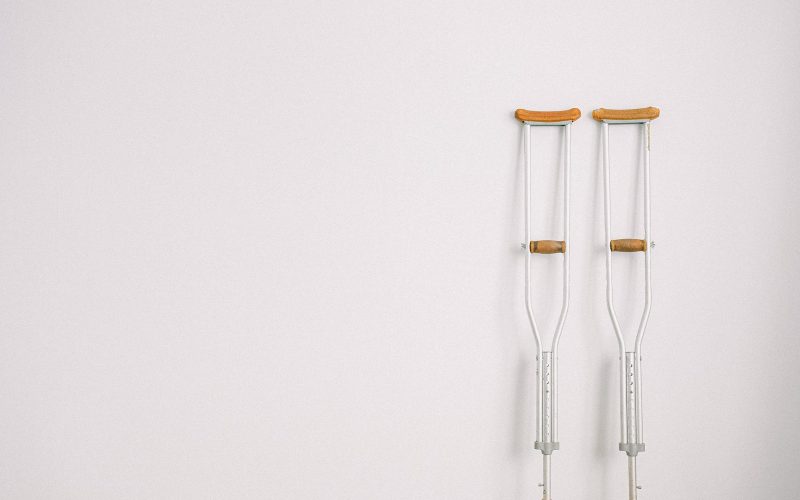Crutches are medical devices designed to aid ambulation by shifting the body weight from the legs to the torso and arms.
Any temporary or permanent condition compromising lower extremity balance and weight bearing with a patient with significant upper body strength and coordination to support and shift their body weight indicates crutches.
There are different types of crutches, most of which are classified into three categories: axilla, forearm, and platform.
Crutches must be measured and adjusted to suit every patient they are given to. Modifying the device to fit the user may reduce adverse events.
Different Types of Crutches
People are more accustomed to the only crutch that patients use to shift their weight to their forearms, but there is more to the types of crutches than just the underarm type.
1. Axillary Crutches
Also known as underarm crutches, this type is the most commonly seen around.
Because of their simplicity and ease of use, they are an ideal choice for most individuals.
They are the best for short-term use and are designed to transfer most of the user’s body weight to the arms and torso.
These crutches are not ideal for individuals with wrist problems, weak upper body strength, or impaired coordination.
These crutches are mainly made of either wood or aluminum, and their models can be adjusted easily with a patient’s overall height and hand height.
2. Forearm Crutches
Less popularly known as Lofstrand or elbow crutch, this type of crutch is better for long-term use.
The weight of the user is transferred mainly to their entire upper arms.
Individuals with long-term disabilities who want to be more active or want to engage in sports may choose forearm crutches.
3. Platform Crutches
This type is the least common of the three classifications; the patient’s weight is transferred mainly to the patient’s forearm.
This crutches type allows the patient more stability than the axilla and forearm crutches and is intended for long-term use.
Individuals with long-term disabilities from severe neurological impairment of their lower extremities with decreased strength may choose this type of crutch.
There are other types of crutches apart from these three discussed.
4. Gutter Crutches
This type of crutch is made explicitly for rheumatoid patients because of their weak grip and joint pain.
A gutter crutch enables patients or older people to maintain balance and distribute their weight if they need to rely on tools.
Gutter crutches are also great for low upper-body strength and balance. They help distribute weight evenly across the forearms and elbows.
5. Knee Crutches
For people with limited mobility or leg injuries, crutches can be stressful because most require using the arms.
Knee crutches are secured around the injured leg, placing pressure and weight on the lower body instead of the upper body.
Axillary and even forearm crutches can hurt the hands, underarms, and wrists when used continuously and non-conventionally.
Knee crutches are designed for slightly less sensitive patients. They don’t have any function for hands or wrists; instead, they can be strapped to the thigh and knee to provide support.
Different Types of Crutch Gaits
We can’t discuss the different types of Crutches without discussing the types of gaits. Gait is the way we walk forward.
With crutches, the dual-legged style has to improvise a little. Maintaining gait is of the utmost importance to getting the maximum benefit from a crutch, whether a non-weight-bearing or partial weight-bearing pattern is to be followed.
1. Two-point Crutch Gait
Good balance is needed to achieve this crutch gait because the pattern is less stable as only two points are in contact with the floor.
In this type of gait, the crutches and affected limb are advanced as one unit, and the uninvolved weight-bearing limb is brought forward as the second unit.
2. Two-point Gait
Similar to these sounds, there is a difference between a two-point crutch gait and a two-point gait.
In a two-point gait, it is known that the right foot and left crutch are brought forward simultaneously, followed by the left foot and right crutch.
There are always two points in contact with the floor at any time.
3. Three-point Gait
This pattern is used with different types of crutches when one of the lower extremities cannot fully support weight. Three points are in contact with the floor.
The crutches are one point, the affected leg is another, and the uninvolved leg is the third. The injured limb steps up to the crutches as both crutches move forward.
The weight-bearing limb follows this movement, stepping beyond the crutches. At any given time, there are always three contact points with the floor.
4. Four-point Gait
This gait pattern is used when there is a lack of coordination, poor balance, and muscle weakness in both lower extremities.
It provides a slow and stable gait pattern with four support points.
Point one is the crutch on the affected side, point two is the unaffected leg, point three is the affected leg, and point four is the crutch on the unaffected side.
The crutches and the limbs are moved separately, with three of the four points on the ground and bearing weight at any given time.
Steps in this gait look random because none of the points on the floor are in the same line.
5. Step-to Gait
When weight-bearing status is restricted to partial, toe-touch, or as tolerated, crutches or a walker are necessary.
The fractured/injured limb is advanced in this gait, and the intact limb is brought to the same position.
This gait helps the patient step to the injured limb by pushing down with the upper extremities, thus transferring weight from the fractured/injured limb to the assistive device.
6. Step through Gait
This gait assumes a two-point or three-point pattern where the intact leg is advanced, and the injured leg is advanced past it.
With restricted weight-bearing, crutches are used instead of the injured limb, and the patient steps past the crutches with the weight-bearing lower extremities.
This gait covers the most distance at any single step.
Conclusion
Crutches are mainly intended to help the user with their utility. Crutch users’ ailments are variable, and their impairments limit the weight they can carry.
Thus, the crutch should add the least weight for the user’s comfort. Depending on the user’s injury severity, different types of crutches are available.
The user’s strength and coordination should undergo evaluation before issuing them a set of crutches. The wrong use of the crutches can lead to injury.
Understanding the different gaits makes the utility of these crutches easier. The most crucial factors to consider when choosing crutches are comfort and gait.








